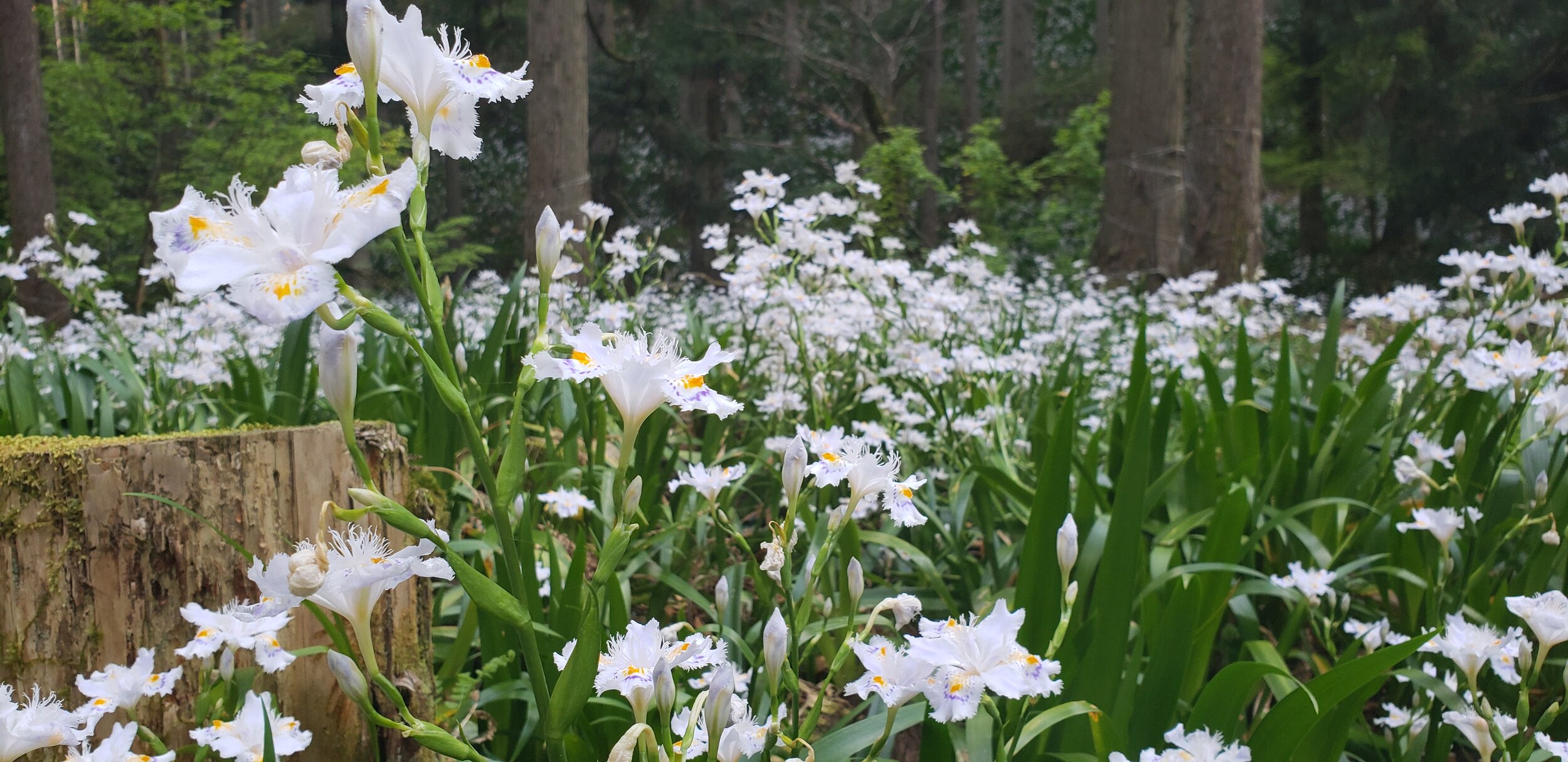AYABE: PEACE & QUITE a lot of nature
Ayabe is located in the southern Kyoto by the Sea area, only an hour by train from Kyoto City. This forested area has hiking trails, flower gardens, and farm stays. The city is known as a place that promotes peace. There is a rose garden that has roses grown from seeds given to the city by Anne Frank’s father to sow world peace. The city is also headquarters to the Omoto Shinto sect. The Omoto Headquarters has lovely grounds that change seasonally and buildings with incredible architecture. It is known worldwide as a multi-denominational place of worship, welcoming people from all faiths. The city is also home to some long-standing historic sites, locations that are still in use today, like the Kurotani Washi paper making village, and Komyoji Temple and national treasure Niomon Gate, which are located in the mountains above Ayabe Onsen, and Gunze Square, a series of museums dedicated to Ayabe’s role in Japan’s textile industry (the Square also includes the Ayabe Gunze Rose Garden with Anne’s Rose). This region is rich with nature, and has some spectacular locations that take just a little bit of seeking and an adventurous spirit.
Ayabe Onsen, Komyoji Temple, and national treasure Niomon Gate
Located in the forests of Ayabe, quite close to national treasure Niomon Gate and corresponding Komyoji Temple, Ayabe Onsen is a great location for some forest therapy. The onsen also has accommodations, a restaurant, local products, and hiking trails close by that lead to the aforementioned temple sites as well as an ancient Japanese Horse Chestnut Tree.
what3words addresses:
Ayabe Onsen (entrance): ///cycling.strengths.sneakily
Niomon Gate: ///boggle.strengthened.awakening
Komyyoji Temple: ///purveyor.symptom.models
Japanese Horse Chestnut Tree: coming soon!
Learn more about Ayabe Onsen on the wellness page, or learn why Niomon Gate is a National Treasure.
Ayabe Gunze Square and Rose Garden
People who visit Ayabe's Gunze Square will have plenty to do, from touring the flower garden, to visiting the museums dedicated to Ayabe's role in Japanese history. There is also a specialty goods shop selling Ayabe products, as well as an area to get tourist information and a cafe. The square is expansive and a great place to relax. It is also in walking distance to a lot of Ayabe's downtown sites, including proximity to the train station.
TEL: 0773-43-0811 (Ayabe Gunze Museum)
address: 1-2 Kamameshi, Aonomachi, Ayabe
admission: free
access [Car] About 5 minutes from Maizuru-Wakasa Expressway "Ayabe IC", about 10 minutes from Kyoto Transit Expressway "Ayabe Ankokuji IC"
[Train] Get off at "Ayabe Station" of JR San'in Main Line / Maizuru Line, about 10 minutes walk from the north exit.
Psst!: There is something incredibly rare and special in the center of Ayabe’s Rose garden. Here is the exact location: ///delivers.quieter.quiet
Omoto Headquarters
Omoto is a religious institution that welcomes people of all faiths. It was founded in Ayabe in 1892. This institution is in the center of Ayabe in the Hongusan area and has a variety of beautiful buildings on the grounds. At Omoto Headquarters, monthly festivals are held (first Sunday of every month), as well as special events like the Setsubun festivals, spring and autumn festivals, Shinto wedding ceremonies, as well as and prayer services for healing illnesses and anxiety
"Choseiden" (the large main building) was built in 1992 and is said to be the largest wooden structure of the 20th century. In addition, the vast garden is full of seasonal flowers, and the autumn leaves are especially beautiful.
The grounds are always open for walking. However the buildings have business hours, and the preserved Former Okabana Residence (on the headquarter’s grounds) requires a reservation ahead of time for entry.
TEL: 0773-42-0187
address: 1-1 Motomiyacho, Ayabe City
what3words address (entrance to grounds): ///zone.marathon.laptop
admission: free
access: [Train] 15 minutes' walk southeast from JR Ayabe Station
Kurotani Washi paper making workshop and village
A paper making village with a history dating back to a ronin samurai 800 years ago. Tour the village and workshops where paper is still being made slowly and carefully, all by hand. Try making washi paper yourself in a small workshop led by one of Kurotani's artisans. When you are finished be sure to visit the gift shop which is filled with amazing paper goods, from fans, to books, and even pillows. Check out the second floor to see some incredible Japanese kimono and obi made entirely out of paper!
cost: 1,000 yen (per person) to make a set of washi paper postcards
300 yen (admission)
hours: 9:00-4:30pm (paper making experience, last experience starts at 3:30pm)
closed: Saturdays, Sundays, holidays
season: closed from January to March (Open only on Saturday & Sunday)
By Train and bus
Take the JR Sanin Main Line to Ayabe Station and exit the station from the south exit.
2 minute’s walk from the [Kurotani Washi Kaikan Mae] stop on Aya Bus Kurotani Line.
By Car
From Kyoto/Osaka
> 15 minutes from the Ayabe Ankokuji IC on the Kyoto Jukan Expressway
what3words address (shop entrance): ///bandage.gliding.doctoral
One of the best ways to immerse yourself in the natural world of Ayabe is to spend the evening in a farm house. There are a variety of locations that will have you out in nature, complete with unique experiences and fresh, natural cuisine. They are also a great way to meet local people and learn about life in rural Japan.





